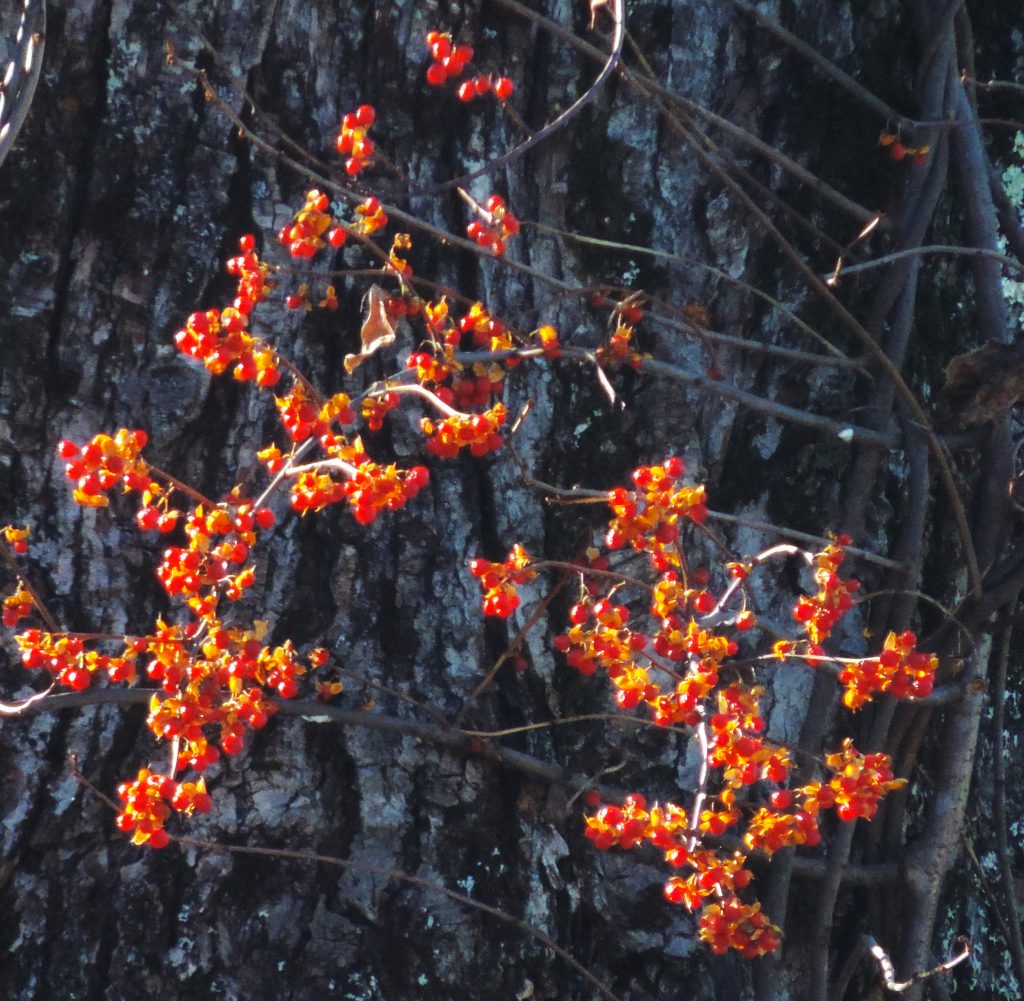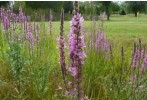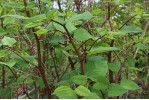
During my childhood on Ragged Mountain, there was a triangular bit of land where three gravel roads converged, called “Bittersweet Corners.” The split-rail fence around this triangle of land was adorned with bittersweet vines, vines that were so beautiful in the autumn when the yellow and orange seeds popped open. We made bittersweet “fairy crowns” for our heads and for our dolls, and we cut tendrils of bittersweet for our Christmas wreaths. But by my adolescence, Bittersweet Corners had changed from a magical childhood fairy garden into a scary tangle. The old apple tree behind the split rail fence no longer bore fruit. Bittersweet vines entwined most of the branches of the apple tree, and the dead branches reached for the sky like blackened fingertips. The split-rail fence had fallen to the ground under the weight of the tenacious vines. By my early adulthood the “answer” to what needed to be done about Bittersweet Corners was to cut down the old apple tree, haul away the fence rails, and uproot and remove the vines, using a “Ditch Witch” digger. Then the road grader came and flattened the triangle of land and covered the area with road gravel.

Have you seen an invasive plant species take over one of your cherished spots? My childhood memory may provide an example of an effort at containment of an invasive plant species in a limited area.
Definition:
An invasive plant species is a species that is non-native to the eco-system, and whose introduction causes or is likely to cause environmental harm or harm to human health. (US Forest Service; 1999 Presidential Executive Order 13112). In 1999 the Federal Government established the National Invasive Species Council. In 2000 New Hampshire passed House Bill 1258-FN, and established the New Hampshire Invasive Species Act. Our state then created the New Hampshire Invasive Species Committee and the New Hampshire Department of Agriculture, Markets, and Food (DAMF) which manages all matters concerning invasive species.
Migrations of peoples and animals, globalization of trade, and climate change all have contributed to the introduction of non-native species of plants to many areas of the world. These new plants enter an ecosystem which do not have the usual insects, parasites and animal predators that may have kept them in check in their natural environment. Not all newly introduced plants become invasive in their new eco-systems. But many do. Why do some newly introduced plants become “invasives?” Why should we be concerned? Biologists report that more than 100 million acres of land in the US are covered with invasive species of plants which have resulted in billions of dollars per year of lost agricultural and forest crops. Invasive plants also have destroyed other natural resources, altered water flow, and depleted soils of natural nutrients. (Douglas Cygan. 2018. NH Guide to Upland Invasive Species, 5th edition).
What makes invasive plant species so successful? Most invasive plants produce large quantities of seed. Their seeds are easily spread by the wind, water, animals, and also (often initially unknowingly) by commercial trade, agriculture, and emigration of peoples. Many invasive plants have aggressive, vast root systems that may extend long distances from a single plant. Their extensive root systems are so dense that they choke out the root systems of nearby native plants. Invasive plants are highly adaptable, they develop early, and have a high tolerance for many environments and climates. Some invasive plants produce chemicals in their leaves and/or roots which are toxic to other plants and may be lethal to some animals. Invasives compete successfully for moisture, sunlight, nutrients, and space, and thus decrease plant diversity. Decreased plant diversity alters wildlife habitats. Invasive plants rapidly change nature’s balance upon which all species depend.

The National Forest Service has developed a very comprehensive four-pronged approach towards control of invasive plant and animal species: 1) Awareness and Prevention 2) Detection 3) Control and Management 4) Restoration and Rehabilitation. As Douglas Cygan, the NH Invasive Species Coordinator, points out, there are many things you can do, as an individual, to help control the spread of invasive species and preserve native flora and fauna. In your yard or on your larger properties minimize impacts to natural vegetation, soils, and drainage. Learn how to identify invasive plants and how to distinguish them from native species. When landscaping, ask your local garden center or your County Extension Service about alternative plantings. Become active in local efforts to control invasives. If you have been working in an area with invasive species, take care to remove soil from your boots or clothing, tires, and equipment, and remove any seeds or burrs from your clothing before returning to your land. Various control methods can be used:
• Mechanical control involves uprooting, digging out, repeated mowing, and cutting, or smothering unwanted species. Mechanical Control methods work best on small areas.
• Advice from the County Extension Service can be helpful in Cultural Control, which involves the planting of native trees and shrubs that can out-compete the invasive species. This may also involve altering an area’s light, moisture, or soil pH.
• Chemical Control involves using an approved pesticide to manage a targeted invasive species. The pesticide applicator must adhere to state and federal pesticide regulations and in many instances must be licensed by the state. For more information about pesticide use: NH Department of Agriculture Pesticide Control Division 603 271-3550, or www.agriculturenh.gov.
• Biological Control involves use of native or introduced beneficial organisms to naturally reduce populations of unwanted species. Most organisms used in biological control are self-sustaining and host specific. Expertise from state biologists is essential for biological control.
A list of New Hampshire’s upland invasive species and a list of contact information can be found in Douglas Cygan’s 2018 5th edition of the “New Hampshire Guide to Upland Invasive Species,” from the New Hampshire Department of Agriculture Markets and Food, Plant, and Industry Division.
For further information, education, and assessment of your property and woodlands you also may contact Tim Fleury, Extension Field Specialist for Natural Resources for Merrimack Co., and Forester for Merrimack Co. Tim.Fleury@nullunh.edu; 603 255-3733. Or contact Ruth Smith, Master Gardner Coordinator. The Master Gardeners also provide education about invasives: ruth.smith@nullunh.edu or 603 351-3831.
Pictures: If you have seen any of these all too familiar invasive plants, consider developing a plan for containment and control. (Pictures are provided with permission from the UNH Extension). For descriptions about the following invasive plant photos (and others not pictured here) see: extension.unh.edu/resource/spotlight-nh-invasive-plants; For more info on Burning Bush: extension.unh.edu/blog/2018/03/invasive-spotlight-burning-bush; For more info on Norway Maple – Alternatives to Invasives: will list what to plant instead! extension.unh.resource/alternatives-invasive-landscape-plants-fact-sheet.